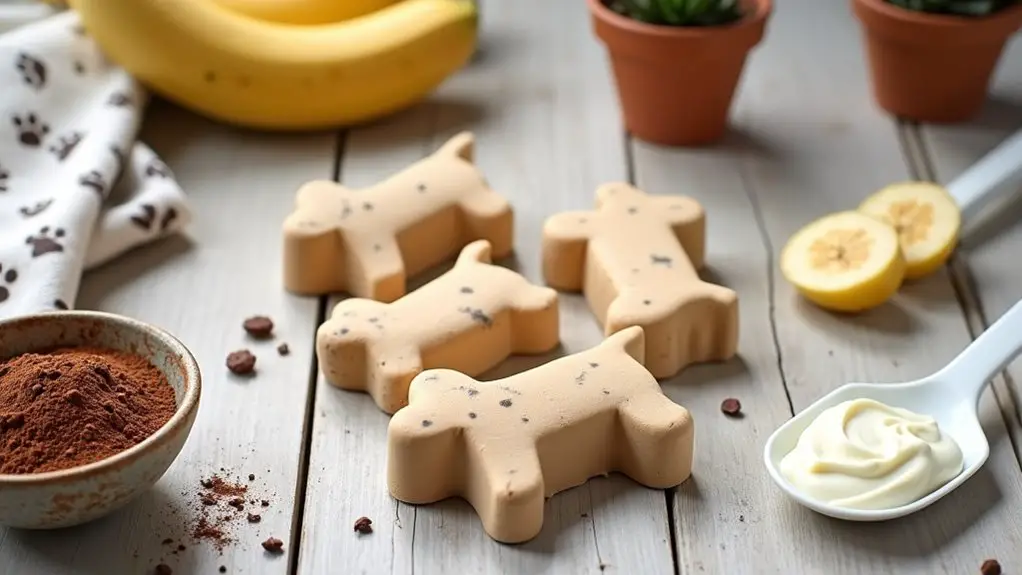Have you ever noticed your pup’s eyes light up at the mention of a treat? Why not turn that excitement into something special with homemade dog ice cream? It’s easier than you think, and trust me, your furry friend will thank you for it (not that you’ll understand any doggy praise). With a few simple ingredients and a little creativity, you can whip up flavors that will have those tails wagging. So, are you ready to give it a go?
Why Homemade?
If you’re wondering why you should whip up some homemade dog ice cream, let me break it down for you.
First off, it’s super easy and way healthier than store-bought options packed with sugar and weird additives. Think about it—you’re in charge of the ingredients. Using simple homemade dog ice cream recipes means your pup’s getting wholesome goodness, not mystery stuff from a label.
Plus, there’s something so satisfying about making treats for your furry friend. Imagine their tail wagging as you scoop out a bowl of creamy delight. You can customize flavors too! Want peanut butter? Sure. How about banana? You got it.
It’s an adventure you share. And the best part? Your dog won’t judge your kitchen skills like your friends might. Trust me, creating something just for them, it’s pure joy.
Ice Cream Variations to Try
If you’re looking to treat your pup to something special, you’ve got to try these ice cream variations.
Picture creamy Peanut Butter Delight or a revitalizing Banana Blueberry Chill just waiting in the freezer.
Trust me, your dog will love the Pumpkin Spice Paws Delight and Coconut Mango Frozen Treats as much as you’ll enjoy making them.
1. Peanut Butter Delight Recipe

Ready to whip up a tasty treat for your furry friend? This Peanut Butter Delight recipe isn’t only easy to make but also customizable, so you can add your own flair. Let’s chat about the ingredients, step-by-step instructions, and a few fun add-ons that’ll make your doggo wag their tail like crazy. With a dog ice cream maker, you can create a variety of frozen goodies perfect for warm days! Not only is this recipe delicious, but it also allows your pup to enjoy healthy frozen treats that are safe and nutritious.
Ingredients
Ready to whip up a delicious treat for your furry friend? This Peanut Butter Delight Dog Ice Cream will have their tails wagging in no time.
Plus, it’s super easy to make with just a few simple ingredients you probably already have in your kitchen. Let’s explore what you’ll need.
- 1 ripe banana, mashed (the riper, the better)
- 1 cup plain Greek yogurt (make sure it’s unsweetened)
- ½ cup peanut butter (lick the spoon, but save some for the mix)
- 1 tablespoon honey (optional, for a touch of sweetness)
- A splash of water (just enough to achieve a creamy texture)
That’s it! Just five (or six) ingredients and you’re on your way to spoiling your pup.
Did I mention that this recipe isn’t just tasty but also packed with protein and healthy fats? Just watch out for that peanut butter; dogs can be sneaky and will try to beg for more while you’re making it.
It’s all part of their charm, right?
Step by Step Instructions
Making homemade dog ice cream can be a fun and rewarding experience for both you and your furry friend. This Peanut Butter Delight recipe is simple and will have your pup wagging its tail in no time. Let’s explore the steps.
- Gather all your ingredients: 1 ripe banana, 1/2 cup peanut butter (make sure it’s dog-safe and without xylitol), and 1 cup plain yogurt (unsweetened and unflavored works best).
- Peel the banana and break it into chunks for easier mixing.
- In a mixing bowl, combine the banana, peanut butter, and yogurt.
- Use a fork or a potato masher to mash the banana until smooth.
- Stir the mixture until all ingredients are well combined (It should be creamy, without lumps).
- Taste a tiny bit yourself (just to make sure it’s not too bland—we all know how picky pups can be).
- Spoon the mixture into ice cube trays or silicone molds, filling them about 3/4 full to allow for expansion as they freeze.
- If you like, add a few dog treats or pieces of fruit on top for extra flavor and fun.
- Place the filled trays in the freezer and let them sit for about 4-6 hours or until solid.
- Once frozen, pop the ice cream pieces out of the molds (you may need to run warm water on the bottom to help them release).
- Serve immediately to your dog or store the treats in a sealed container in the freezer for later.
Cool completely before serving to your dog. Enjoy the messy, puppy-smooching aftermath.
Optional Add-ons
Now that you’ve whipped up a batch of Peanut Butter Delight for your pup, why not amp up the fun with some optional add-ons?
Try tossing in mashed bananas for a fruity twist, or perhaps a sprinkle of crushed dog-friendly biscuits for crunch. Your pup won’t know what hit ‘em.
Mixing it up keeps things exciting—after all, variety is the spice of life, right?
2. Banana Blueberry Chill
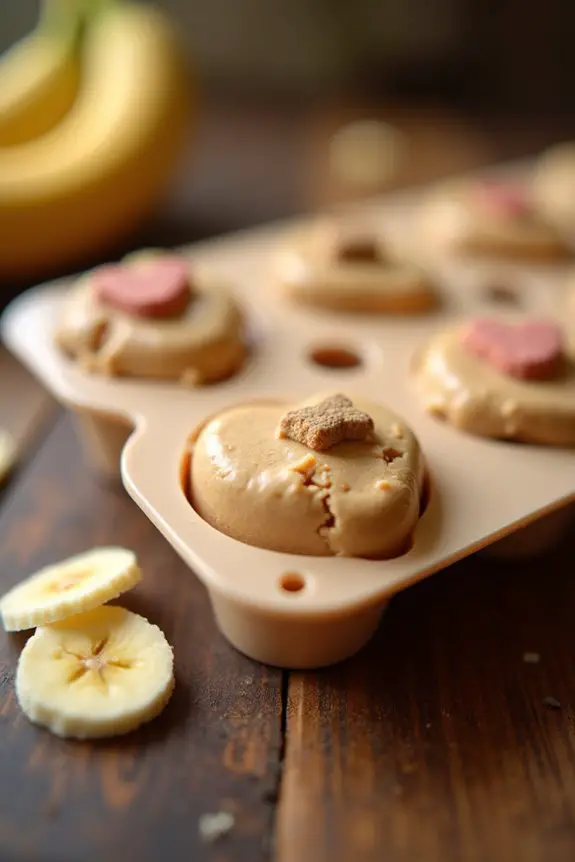
Ready to cool down your pup with a tasty Banana Blueberry Chill? Let’s gather some simple ingredients and follow a few easy steps to whip up this invigorating treat. And don’t forget, you can always toss in some optional add-ons to make it even more exciting! To add a touch of style, consider dressing your dog in designer dog clothes while they enjoy their treat.
Ingredients
This Banana Blueberry Chill isn’t just a treat for your furry friend, it’s a delightful way to beat the heat with a fresh burst of flavor. Your dog will be wagging that tail in pure bliss after enjoying this homemade ice cream.
Plus, it’s super easy to make with ingredients you’ll find in your kitchen or local store.
- 2 ripe bananas, mashed (the riper, the better for sweetness)
- 1 cup blueberries (fresh or frozen, both work well)
- 1 cup plain, unsweetened yogurt (Greek yogurt can be a nice protein boost)
- 1 tablespoon honey (for a touch of extra sweetness; optional for dogs under one year)
- ½ cup water (adjust for consistency)
Just gather these ingredients, and you’re on your way to creating a cool treat that will have your pup thinking you’re a culinary genius.
Seriously, who needs fancy dog parlors when you can whip up something like this at home?
Now, let’s get to mixing, because your dog’s next favorite snack is just a blend away!
Step by Step Instructions
- Gather all your ingredients: 2 ripe bananas, 1 cup of blueberries, 1 cup of plain yogurt, and a splash of water.
- Peel the bananas and break them into chunks.
- Place the banana chunks and blueberries into a blender or food processor. Don’t worry about getting every bit of skin, your dog won’t mind!
- Pour in the yogurt and add a splash of water to help blend smoothly (but not too much—let’s not drown the fruit).
- Blend the mixture until smooth, checking occasionally to see if it needs a little more yogurt or water to blend properly.
- Taste the mixture if you’re feeling adventurous (not too sweet, right? Just perfect for pups!).
- Pour the blended mix into ice cube trays or silicone molds for fun shapes.
- Cover the trays or molds with plastic wrap or a lid to keep them safe from the freezer’s chilly breath.
- Freeze for about 4–6 hours, or until solid. You can tell they’re ready when they feel rock hard.
- Remove from the freezer and gently pop out the ice cream treats.
Serving note: Cool for a minute to avoid icy tongues, then serve to your dog and watch them enjoy every lick.
Optional Add-ons
If you think the Banana Blueberry Chill is a tail-wagging hit all on its own, wait until you explore some fun add-ons that can elevate this treat to the next level.
Consider tossing in some peanut butter for extra flavor, or blend in a splash of coconut milk for creaminess.
Your pup will be begging for more, and you’ll feel like the ultimate dog chef.
3. Pumpkin Spice Paws Delight
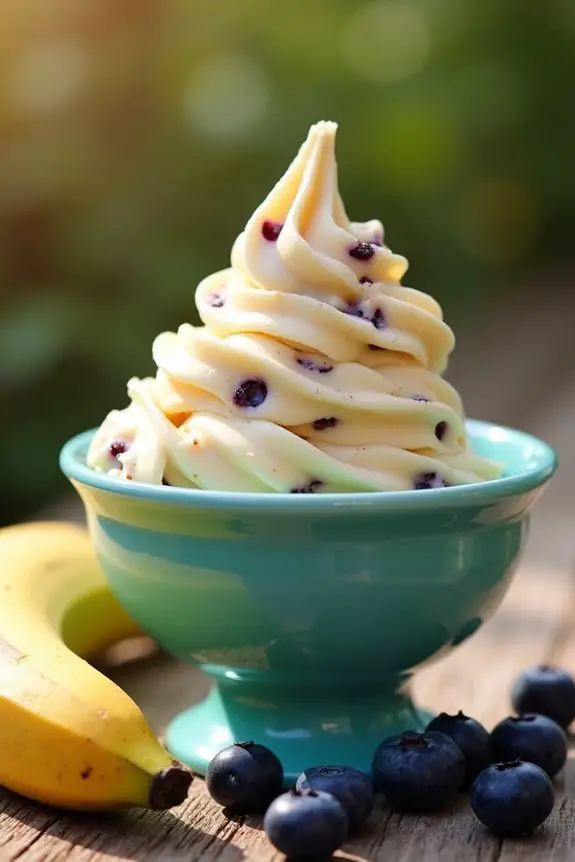
Ready to whip up some Pumpkin Spice Paws Delight? You’ll need just a few simple ingredients, and I promise your furry friend will go nuts over it. Let’s walk through the step-by-step process, and I’ll even throw in some optional add-ons to take it to the next level. Additionally, using a high-quality ice cream mix for dogs can enhance the flavor and make it extra special for your pup! It’s also important to choose premium dog food that supports your Goldendoodle’s health needs, ensuring a happy and active lifestyle.
Ingredients
If your pup is anything like mine, they’re always eyeing our ice cream cones with those big, soulful eyes. It’s hard to resist, right?
But the good news is, you can whip up a scrumptious treat that’s safe and tail-wag-approved. This Pumpkin Spice Paws Delight isn’t only easy to make, but it’s also packed with flavors that will have your dog begging for more.
So, grab your apron and get ready to treat your furry friend to a delicious homemade ice cream!
- 1 cup plain yogurt (unsweetened and unflavored)
- ½ cup canned pumpkin (not pumpkin pie filling)
- 2 tablespoons peanut butter (make sure it’s xylitol-free)
- 1 tablespoon honey (optional, and skip if your pup is under one year old)
- 1 teaspoon cinnamon
- 1 pinch of nutmeg (optional, just a tiny bit for that extra spice)
Just picture those happy tails wagging and those joyful barks as your pooch indulges in this special treat.
It’s like you’re the coolest dog parent on the block. You might even get a few extra kisses for your creativity.
Who knew making dog ice cream could be this easy and fun?
Step by Step Instructions
1. Gather all your ingredients: 1 cup of pumpkin puree, 1 cup of plain yogurt (unsweetened), 1 tablespoon of honey (optional), and a sprinkle of cinnamon.
2. In a mixing bowl, combine the pumpkin puree and yogurt.
3. Whisk the mixture together until it’s smooth and combined—no lumps allowed here, but don’t go crazy; it should be creamy and happy.
4. If you want a touch of sweetness, stir in the honey and mix well.
(Just a heads-up, if your pup is really strict about sugar, you can skip this step).
5. Add a dash of cinnamon to the mixture and fold it in.
This is where the magic happens—smell that deliciousness?
6. Pour the mixture into silicone molds or ice cube trays for easy serving.
7. Use a spatula to smooth the top, making it look nice and neat.
(Slightly over the edges? Don’t stress—your dog won’t mind).
8. Place the molds in the freezer and let them freeze for at least 3-4 hours, or until they’re solid.
Like, really solid. No one likes a melty ice cream…
9. Once frozen, pop the dog ice cream out of the molds.
(You might need to let them sit at room temperature for a minute to help them come out easy-peasy).
10. Serve to your furry friend and watch their tail go into overdrive.
Cool completely before serving to your dog. Enjoy the wagging tails and slobbery kisses.
Optional Add-ons
Wondering how to take your homemade dog ice cream to the next level?
Try adding pumpkin puree and a sprinkle of cinnamon for a Pumpkin Spice Paws Delight that’ll make your pup wag with joy.
It’s easy! Just mix in a couple of tablespoons of pumpkin and a pinch of spice before freezing.
You’ll be the coolest pet parent around, trust me!
4. Coconut Mango Frozen Treats
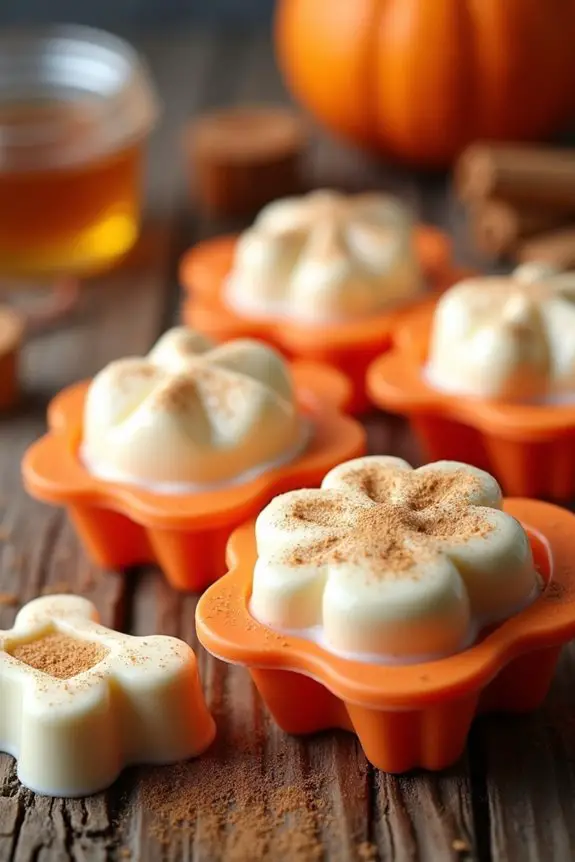
Ready to whip up some Coconut Mango Frozen Treats for your pup?
You’ll need just a few simple ingredients, and I promise, it’s easier than that time I almost set my kitchen on fire baking cookies.
Let’s walk through the steps together and sprinkle in some optional add-ons to make it even more special for your furry friend.
Ingredients
When it’s hot outside, there’s nothing quite like a invigorating treat for our furry friends.
These Coconut Mango Frozen Treats aren’t only delicious but also packed with ingredients that are safe and healthy for dogs.
Plus, it’s a fun way to beat the summer heat and show your pup some love.
So, let’s gather what we need to make this delightful treat!
- 1 cup ripe mango, chopped (fresh or frozen)
- 1 cup coconut milk (make sure it’s unsweetened and without additives)
- 1 tablespoon honey (optional, but dogs often love a little sweetness)
- 1 banana, mashed (for extra creaminess and flavor)
- 1/2 cup plain Greek yogurt (make sure it’s unsweetened and contains no artificial sweeteners)
Just imagine the joy on your dog’s face when you hand them a bowl of this tasty goodness!
Who knew being a dog cook could be so rewarding?
Grab your ingredients, and let’s get this party started.
Step by Step Instructions
1. Gather all your ingredients: 1 cup of coconut milk, 1 cup of ripe mango (diced), and 2 tablespoons of honey or a dog-friendly sweetener.
2. In a blender, add the diced mango and coconut milk.
(Make sure your mango is oh-so ripe for the best flavor.)
3. Blend until smooth and creamy, about 30 seconds to a minute.
(It should look like a dreamy smoothie—no chunks allowed.)
4. Taste the mixture to verify it’s sweet enough for your pup.
Add honey if needed, and blend again for 10 seconds.
5. Pour the mixture into ice cube trays or silicone molds.
(Don’t be afraid to lick the spoon—you know you want to!)
6. Place the trays in the freezer and let them freeze for at least 4 hours, or until solid.
(Time for a little patience; your pooch will thank you later.)
7. Once frozen, remove the ice cream treats from the trays by gently pulling or twisting.
(If they’re being stubborn, run warm water on the outside of the tray for a few seconds.)
8. Serve one to your dog and watch their tail wag like crazy!
9. Enjoy the moment.
(Remember to cool completely before giving them to your dog, because melted treats can be messy.)
Optional Add-ons
If you’re looking to kick things up a notch with your dog’s homemade ice cream, you’re in for a treat.
Try adding some coconut and mango for a tropical twist. Simply blend ripe mango, coconut milk, and a bit of honey (if your dog’s okay with it).
Freeze, scoop, and watch your pup go wild! It’s like a vacation in a bowl.
5. Peachy Paws Frozen Delight

Ready to whip up a sweet treat your pup will adore? For this Peachy Paws Frozen Delight, you’ll need just a few simple ingredients, plus I’ll guide you through easy step-by-step instructions. And hey, if you want to jazz it up a bit, I’ve got some fun optional add-ons that could make your dog’s taste buds dance.
Ingredients
When the heat is on, our furry friends deserve a cool treat just like we do. This peachy paws frozen delight isn’t only invigorating but also packed with flavors that will have your pup wagging their tail in joy.
Let’s gather some simple ingredients and whip up a batch of this dog-friendly ice cream. Just remember, it’s peachy perfection for your pooch! Here’s what you’ll need:
- 2 ripe peaches, pitted and diced (fresh is best, but if you can’t resist those little frozen ones, go ahead)
- 1 cup plain yogurt (make sure it’s free of sweeteners and flavors)
- 1 tablespoon honey (if your dog is under one year, skip this sweetener)
- 1/2 cup unsweetened coconut milk (creamy and delicious, your dog will love it)
- 1/4 cup dog-friendly peanut butter (be sure it’s xylitol-free)
- A sprinkle of cinnamon (just a pinch for taste—dogs often love it)
That’s it! Just a few easy ingredients you probably have at home.
Now, imagine the delight on your pup’s face as they enjoy their special treat. Your kitchen might turn into a bit of a mess, but hey, a little chaos just means you’re having fun, right?
Now, let’s get to making this tail-wagging dessert.
Step by Step Instructions
To whip up this delightful Peachy Paws Frozen Delight for your furry friend, gather your ingredients and get ready for some simple steps. Your pup will be wagging their tail in no time, and trust me, you’ll be their favorite chef. Let’s get started!
- Peel and chop two ripe peaches into small pieces, discarding the pit. (Fresh fruit is always a win for canine taste buds!)
- Place the chopped peaches into a blender or food processor.
- Add one cup of plain yogurt (make sure it’s unsweetened and free of artificial flavors).
- Drizzle in one tablespoon of honey (if your dog is under one year old, skip this step).
- Blend the mixture until smooth, with a few small peach chunks remaining for texture. (Visual cue: it should look creamy and peachy).
- Pour the peachy mixture into silicone ice cube trays or dog-safe molds.
- Insert dog-friendly treats, like small biscuits or bits of banana, into the molds for added fun.
- Freeze for at least 4 hours or until completely solid. (Check with a gentle poke—the treats should be rock hard).
- Once frozen, carefully remove the treats from the molds, tapping gently if they stick.
- Treat your pup, but don’t forget—these yummy delights are best given as an occasional treat, not a meal replacement.
Cool completely before serving to your dog, and watch their tail wag in appreciation.
Who wouldn’t love a homemade, peachy frozen treat? Enjoy the smiles (and slobber).
Optional Add-ons
Adding a little twist to your Peachy Paws Frozen Delight can make treat time even more exciting for your furry friend.
Try mixing in crushed bananas or a spoonful of peanut butter—trust me, they’ll tail wag with joy. You could even toss in some blueberries for a tasty surprise.
A few fun add-ins can create a treat that’s anything but ordinary. Who doesn’t love variety?
6. Apple Cinnamon Frozen Delight
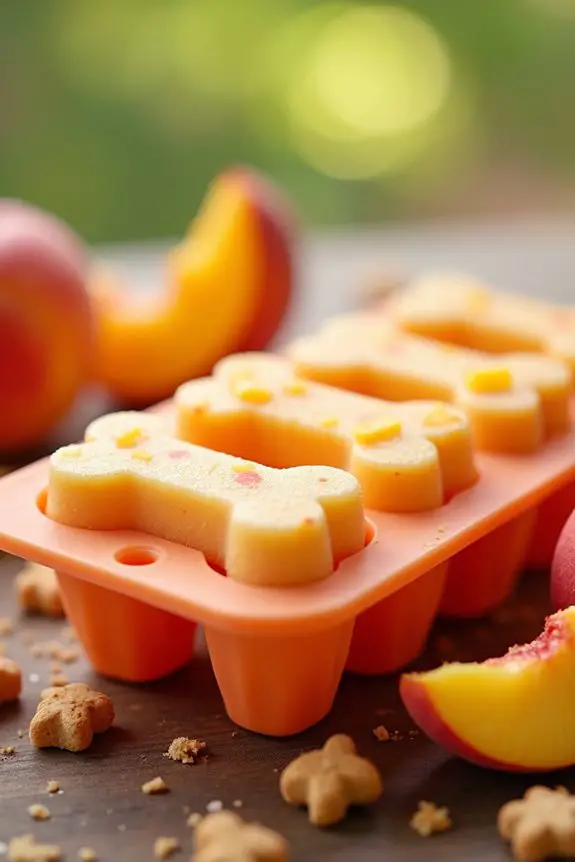
Craving a cool treat for your pup? The Apple Cinnamon Frozen Delight isn’t only simple to whip up, but your dog will love every lick. Let’s get into the ingredients, some easy-to-follow instructions, and a few fun add-ons to make this freeze-worthy snack even better.
Ingredients
Ready to whip up a delicious treat for your furry friend? This Apple Cinnamon Frozen Delight is easy to make, and I guarantee your pup will love it! Here’s what you’ll need to grab from your kitchen:
- 2 ripe apples, cored and diced (leave the skin on, it’s extra fiber)
- 1/2 cup plain yogurt (make sure it’s unsweetened and free of xylitol)
- 1 tablespoon honey (optional; use sparingly, of course)
- 1 teaspoon cinnamon (just a pinch can make it delightful)
- 1/4 cup peanut butter (look for all-natural, without any added sugar)
- 1/2 cup water (to help blend everything smoothly)
There you have it—a quick shopping list that won’t break the bank, and your pup will appreciate every lick.
I mean, who can resist apple and cinnamon? If only I could have some too, but then I’d need my own doggie ice cream recipe—oh, the struggle is real.
Step by Step Instructions
1. Gather all your ingredients: 1 ripe banana, 1 cup of low-fat plain yogurt, 1 tablespoon honey, and 1 teaspoon cinnamon.
You want everything ready to go before you start—like prepping for a fun doggy culinary adventure.
2. Peel the banana and cut it into small chunks. This will make it easier to blend.
3. Place the banana chunks in a blender or food processor. It’s time to get blending, and let’s be real, who doesn’t love the sound of that motor whirring?
4. Add the yogurt, honey, and cinnamon to the blender. Make sure to scrape the sides so nothing gets left behind. Every bit counts, right?
5. Blend on high until the mixture is smooth and creamy, about 30 to 60 seconds. It should look like a delightful banana smoothie — just maybe not something you’d want to drink.
6. Pour the mixture into ice cube trays or silicone molds. You could also use paper cups, but this ice cream is for good pups, not a toddler art project.
7. Cover the trays or molds with plastic wrap, if needed. This keeps out any pesky freezer odors that might spoil the fun.
8. Freeze for at least 4 hours or until solid. It’s the waiting game now; your dog’s drool may start to build during this time.
9. Once fully frozen, pop the frozen treats out of the trays or molds. If they’re sticking, run warm water over the bottom for a few seconds.
10. Serve them to your dog, preferably outside (your best friend is going to need some space for the inevitable “delicious mess”).
Cool completely before serving to your dog, and watch that tail wag. Enjoy the smiles!
Optional Add-ons
If you’re looking to spice up your dog’s ice cream experience, consider adding a delightful twist with an Apple Cinnamon Frozen Delight.
Just blend one ripe banana, a cup of plain yogurt, a diced apple, and a sprinkle of cinnamon.
Pour it into molds, freeze, and watch your pup’s tail wag!
It’s like a cozy treat straight from your kitchen—without the mess.
7. Carob and Yogurt Delight
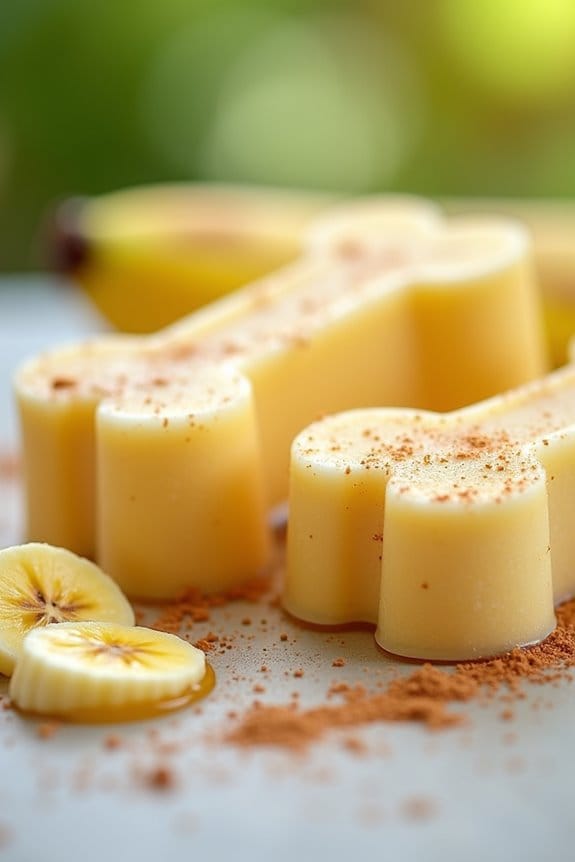
Ready to treat your furry friend to something special? The Carob and Yogurt Delight combines creamy yogurt with the rich, chocolatey flavor of carob, creating a dog-friendly ice cream that’s bound to be a hit.
Let’s go over the ingredients, step-by-step instructions, and maybe toss in a few optional add-ons to take it to the next level, because who doesn’t love a little extra flair?
Ingredients
If you’re looking to pamper your furry friend with a special treat, this Carob and Yogurt Delight ice cream is just the ticket. It’s so easy to whip up, and trust me, your pup will love it.
Plus, homemade means you know exactly what’s going into their treats—no sneaky chemicals or preservatives here. So, let’s gather those ingredients and get started!
- 1 cup plain, unsweetened yogurt (make sure it’s safe for dogs)
- 1 ripe banana, mashed (the riper, the sweeter)
- 2 tablespoons carob powder (a dog-friendly chocolate substitute)
- 1 tablespoon honey (optional, for those dogs who need a little sweet)
- 1 cup peanut butter (make sure it’s xylitol-free, please)
- 1 cup water (or use chicken broth for extra flavor)
Now, isn’t that a cinch?
It’s like a mini shopping spree in the grocery aisle for your pup! Just imagine their little wagging tails when they get a taste of this creamy goodness. I mean, who can resist those puppy-dog eyes?
Step by Step Instructions
- Gather your ingredients: You’ll need 1 cup of plain yogurt, 2 tablespoons of carob powder, and 1 ripe banana. Make sure you have some dog-friendly molds or ice cube trays handy.
- Peel the banana and mash it in a bowl until smooth (no lumps allowed here, we’re not making banana bread).
- In a separate bowl, mix the yogurt and carob powder together until well combined. If it looks a bit gritty, just keep stirring; it should be smooth like a puppy’s chin.
- Pour the mashed banana into the yogurt mixture and fold gently using a spatula (be careful not to overmix, we want a bit of banana goodness peeking through).
- Grab your molds or ice cube trays and carefully spoon the mixture into them. Fill them evenly, but don’t overfill—trust me, no one wants a messy freezer.
- Tap the molds gently on the counter to remove any air bubbles (this is where you can pretend you’re a gourmet chef impressing your friends).
- Place the filled molds in the freezer and let them freeze for at least 4 hours or until solid (patience, my friend; the wait is worth it).
- When they’re ready, take them out and let them sit at room temperature for a minute before trying to remove them—this helps prevent breakage (and because no one likes a stubborn ice cube).
- Serve them to your pup and watch the joyous tail wagging begin. Cool completely before serving to your dog, unless you want to see them do an adorable little dance while waiting.
Optional Add-ons
When it comes to giving your dog a cool treat, why stick to just one flavor?
Try mixing in some carob for a rich, chocolate-like twist—just remember, it’s dog-safe!
Or add a dollop of plain yogurt for a tangy kick.
Your pup will love the surprise, and let’s be honest, you might just want to taste it too. Who could resist?
Perfect Portion Sizes
Getting the portion sizes just right can be a bit tricky, but don’t worry—it’s not rocket science. When whipping up homemade dog ice cream, think about your pup’s size. Smaller dogs might only need a couple of tablespoons, while larger breeds may enjoy a half-cup serving. You want to treat them but not ice them out for dinner.
Start with a single scoop and observe their reaction. Is your pup wagging their tail or doing the happy dance? That’s a good sign. Too much too fast can lead to a zippy trip outside.
Here’s a tip: Freeze in ice cube trays for easy portion control. Each cube’s just the right size for a quick treat.
I’ve even caught myself sneaking a bite—don’t judge, it’s banana and peanut butter!
Ultimately, moderation is key. You’ll find the sweet spot with a little trial and error, and your pup will thank you for it.
Frequently Asked Questions
Can Puppies Eat Homemade Dog Ice Cream?
Yes, puppies can eat homemade dog ice cream, but make certain it’s made from dog-friendly ingredients. Avoid additives like sugar, chocolate, or dairy. Always introduce new treats gradually to monitor for any adverse reactions. Enjoy creating!
How Long Can I Store Homemade Dog Ice Cream?
You can store homemade dog ice cream in your freezer for about two to three weeks. Just make sure to keep it in an airtight container to maintain freshness and prevent freezer burn. Enjoy!
What Ingredients Should I Avoid in Dog Ice Cream?
Avoid ingredients like chocolate, xylitol, caffeine, grapes, raisins, and artificial sweeteners in dog ice cream. These can be toxic to dogs. Stick to safe fruits, plain yogurt, and peanut butter for a tasty treat your pup will love.
Can I Use Human Ice Cream Recipes for Dogs?
You can’t use human ice cream recipes for dogs. Many ingredients in human ice cream, like sugar and chocolate, can harm your pup. Instead, stick to dog-friendly ingredients to keep your furry friend safe and happy.
How Often Can I Give My Dog Ice Cream?
You can give your dog ice cream occasionally, about once a week. Just make sure it’s dog-friendly, low in sugar, and free from harmful ingredients. Balance is key, so monitor your pup’s reactions too.

Hi, I’m Ali Tarek, the founder of Animalsman. I’ve always been passionate about pets, especially dogs and cats, and I created this website to share practical tips, easy recipes, and helpful care advice for fellow pet lovers. My goal is to make pet care simple, enjoyable, and accessible for everyone. When I’m not writing or curating content, you’ll usually find me spending time with my furry friends or learning new ways to keep them happy and healthy.

